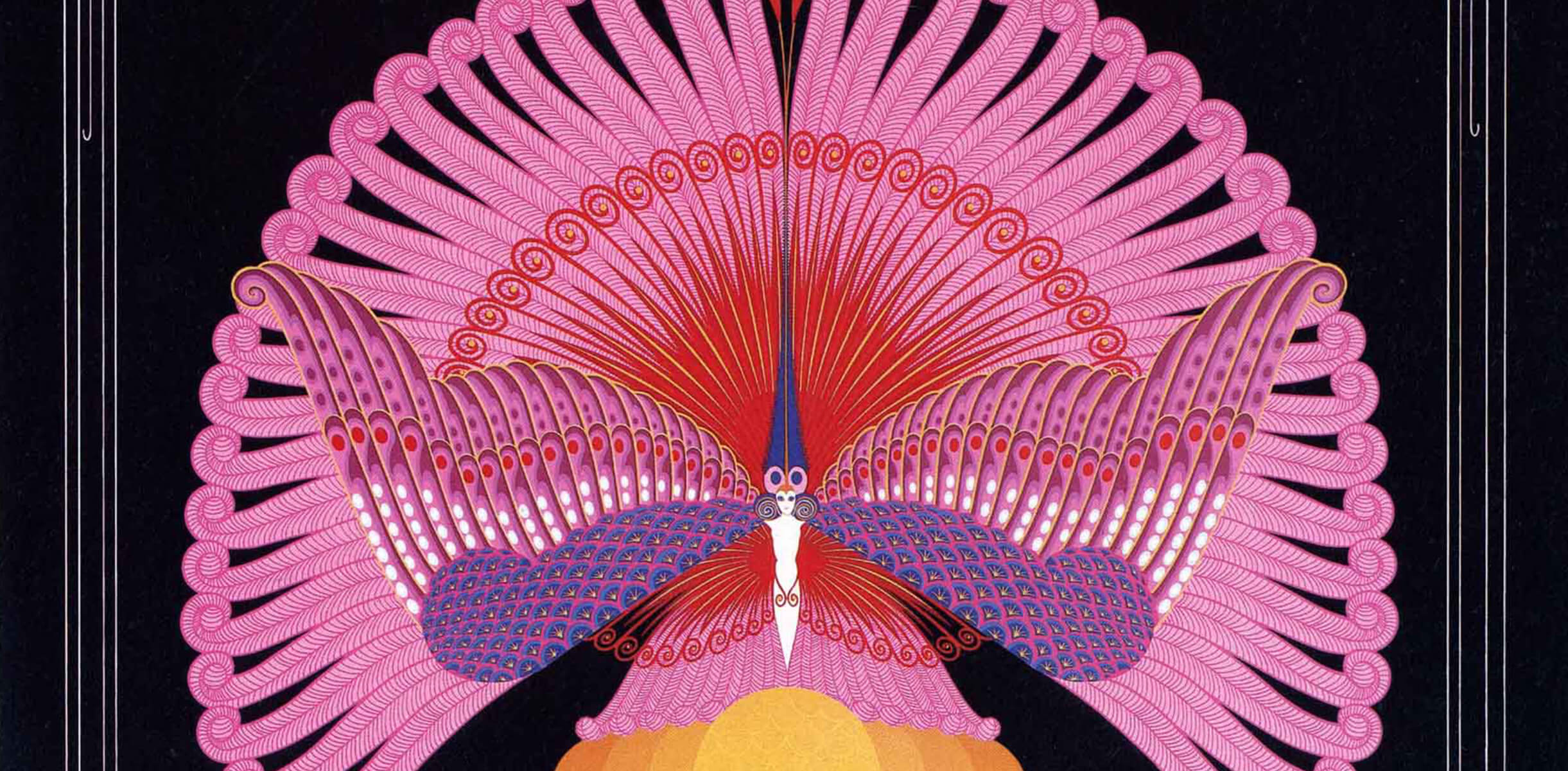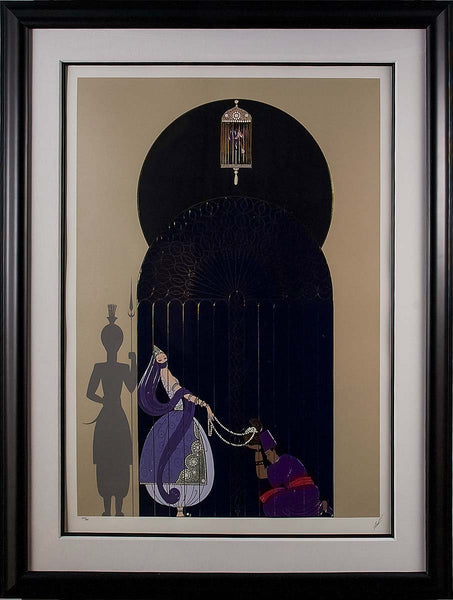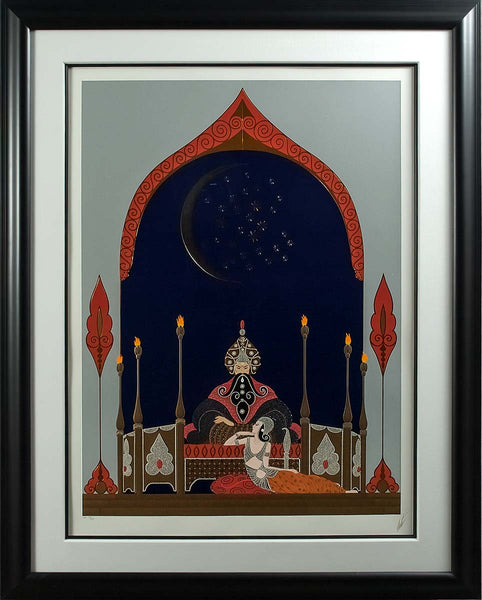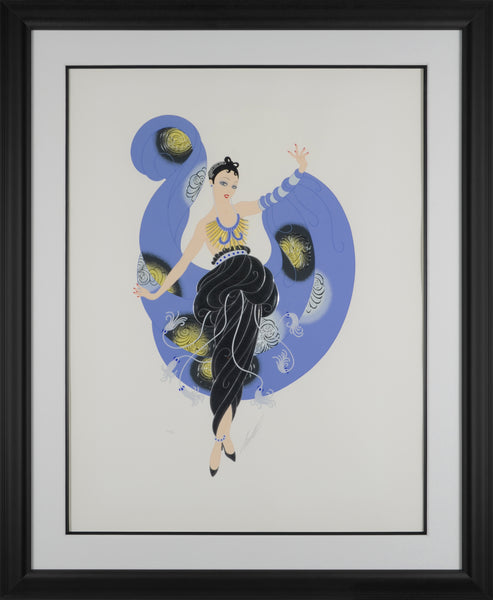
Widely celebrated as one of the icons of Art Deco, Erté (1892–1990) was born Romain de Tirtoff into an aristocratic family in Saint Petersburg. Rejecting his family’s military tradition, he instead followed the pull of the arts, moving to Paris at age twenty. There, immersed in the cultural ferment of the early 20th century and deeply influenced by his early exposure to opera and ballet, he found his lifelong métier.
Erté adopted his pseudonym from the French pronunciation of his initials (“R.T.”), marking his reinvention as a Parisian artist. His first post was with couturier Paul Poiret, for whom he illustrated garments and assisted with stage productions that echoed the exoticism of the Ballets Russes. Even in these early works, one sees the hallmarks of his later career: fantastical costumes, theatrical detail, and an instinct for glamour rendered with precise, linear draftsmanship.
By 1914, Erté had secured his breakthrough contract with Harper’s Bazar. Over the next two decades he designed more than 240 covers, each one a dazzling articulation of Art Deco modernity—stylized silhouettes, jewel-toned palettes, and compositions of elegant restraint. Simultaneously, he was commissioned by major department stores like Henri Bendel and B. Altman, as well as theaters from the Folies-Bergère to Broadway.
In 1925, Metro-Goldwyn-Mayer Studios invited him to Hollywood, where he designed sets and costumes for films such as Ben-Hur and La Bohème. Though he did not exhibit at the 1925 International Exposition of Decorative Arts in Paris, the event that gave “Art Deco” its name, his work decisively shaped the movement’s international vocabulary. His 1926 exhibition at Galerie Charpentier brought him into France’s national collections, confirming his place in the cultural canon.
Though his visibility waned after World War II, the 1960s revival of interest in Art Deco reintroduced Erté to a new audience. The most decisive event came in 1967, when his close friendship with Eric and Salome Estorick led to a monographic exhibition of gouaches at Grosvenor Galleries in London and New York. On the eve of the New York opening, Erté was astonished to find red stickers affixed to every piece. The gallery manager informed him that The Metropolitan Museum of Art had purchased the entire exhibition en bloc, in a joint acquisition by the Department of Prints and Photographs and The Costume Institute.
To celebrate this bold move, the Museum mounted the exhibition Erté and Some of His Contemporaries in 1968. Because monographic exhibitions of living artists were not yet permitted, the show juxtaposed Erté with Bakst, Dufy, and Goncharova, artists who had influenced or paralleled his career. Erté described the event as “the outstanding event of 1968” and was deeply moved by the reception, especially the enthusiasm of young visitors.
From the late 1960s onward, Erté’s star rose once more. He expanded into bronze sculpture and limited-edition serigraphs which translated his signature linear elegance into collectible works of art. In the 1980s especially, these prints became highly innovative objects in their own right, incorporating embossing, gold and silver foil stamping, and the dramatic use of dark grounds or black paper. Such techniques gave the serigraphs jewel-like luminosity and sculptural tactility, transforming them from reproductions into luxury editions that embodied Erté’s lifelong pursuit of glamour and refinement.
In 2025, as the world commemorates the centenary of Art Deco, Erté’s vision feels strikingly current. His work was not merely ornamental but systematized glamour: geometry, drama, and elegance distilled into line, color, and form. From fashion houses to interior designers, the visual language he codified still underpins what we recognize as modern luxury.
Erté’s creations reside in the world’s leading collections, including The Metropolitan Museum of Art, the Los Angeles County Museum of Art, and the Victoria and Albert Museum. For collectors today, his gouaches, graphics, and bronzes remain highly sought-after, not only as works of great beauty but also as touchstones of design history.
Each work embodies what Erté achieved so singularly: the ability to transform modern life into theater, elegance into an art form, and the fleeting fashions of the early 20th century into timeless expressions of beauty.






